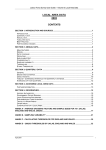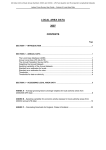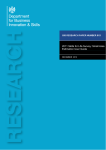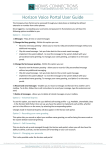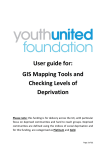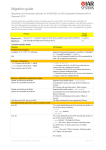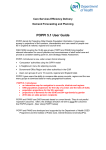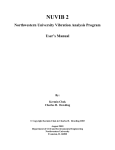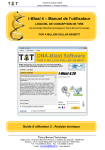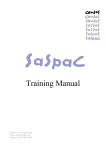Download 2011 Census Origin-Destination Data User Guide
Transcript
2011 Census Origin-Destination Data User Guide 1. 2. 3. 4. 5. What is origin-destination data? ............................................................................................... 2 1.1 Table names ....................................................................................................................... 2 1.2 Geography .......................................................................................................................... 3 Special Migration Statistics ........................................................................................................ 3 2.1 International Migrants ....................................................................................................... 3 2.2 Geography for Migration Tables ........................................................................................ 4 2.3 Usual residents aged under 1 ............................................................................................ 4 Special Workplace Statistics....................................................................................................... 5 3.1 Defining a quasi workplace ................................................................................................ 5 3.2 Quasi workplaces comparability with 2001 ....................................................................... 5 3.3 Geography for Workplace Tables ...................................................................................... 7 3.4 Differences between UK countries .................................................................................... 7 Special Residence Statistics........................................................................................................ 8 4.1 Quasi codes ........................................................................................................................ 8 4.2 Geography for Residence Tables ....................................................................................... 8 4.3 Limitations.......................................................................................................................... 9 Special Student Statistics ........................................................................................................... 9 5.1 6. Geography for Student Tables ........................................................................................... 9 Accessing the data ................................................................................................................... 10 6.1 Public data........................................................................................................................ 10 6.2 Safeguarded data ............................................................................................................. 10 6.3 Secure data ...................................................................................................................... 11 7. The 2011 Census ...................................................................................................................... 11 8. How you should cite the data .................................................................................................. 11 9. Other census products ............................................................................................................. 12 1. What is origin-destination data? Origin-destination data is also known as flow data and shows the flows of people from one place to another. Flow tables show basic flows between areas, univariate tables cross-tabulate flows with one other variable, and multivariate tables cross tabulate flows with more than one variable. There are four types of origin-destination data for the 2011 Census: Special Migration Statistics – show the migration patterns (both internal and international) of individuals based on their location 1 year prior to Census Day (27 March 2011) Special Workplace Statistics – show the commuting patterns of individuals Special Residence Statistics – provide information on the location of second residences in relation to an individual’s usual residence or workplace Special Student Statistics – show the migration patterns of individuals living at student addresses one year prior to the Census More information about each of these types of data is provided in sections 2 to 5 below. Table layouts for origin-destination are available here. 1.1 Table names Data Type: M = Migration R = Residence S = Student W = Workplace Table Number Country: EW = England & Wales NI = Northern Ireland UK = United Kingdom MU06AEW_all Table Type: F = Flow U = Univariate M = Multivariate Table Number Subset (optional): Migration tables – tables that have the same variable but a different categorisation are differentiated by this letter. Second residence tables – A = second address outside UK collapsed B = second address outside UK detailed Student tables – not applicable. Workplace tables (UK) – A/D = excluding quasi workplaces B/C/E/F = including quasi workplaces Workplace tables (EW) – not applicable. Migrant Population (Applicable to migration tables only): _all = living at a different address one year before the census _non_uk = living outside the UK one year before the census 1.2 Geography This table shows the geographies that are used in the Origin-Destination tables and the equivalents for these geographies across the UK. Click on each geography for more information. Additional information about the geographies used for each set of tables is provided in sections 3 to 6 below. England and Wales Merged Local Authority 2011 Census Merged Ward MSOA (Middle Layer Super Output Area) OA (Output Area) WPZ (Workplace Zone) Northern Ireland Local Authority Ward SOA (Super Output Area) Scotland Local Authority Ward IZ (Intermediate Zone) SA (Small Area) N/A OA (Output Area) N/A For the merged Local Authority hierarchy, the London boroughs of Westminster and City of London have been merged, and Cornwall UA has been merged with the Isles of Scilly UA. All other London boroughs, unitary authorities and districts in England and unitary authorities in Wales remain unmerged in this hierarchy. 2. Special Migration Statistics The Special Migration Statistics (SMS) show migration patterns of those who lived at a different address one year before the census. With the exception of table MF02 (UK/EW/NI) there are two versions of each SMS table – one that includes all migrants (anyone who was living at a different address one year before the census), and one that includes international migrants only (anyone who was living outside the UK one year before the census). 2.1 International Migrants The tables that include all migrants do not contain the full detail of the origin for addresses that were outside of the UK, but instead use an ‘Outside UK’ grouping with a quasi code of OD0000009. The tables that include international migrants only provide detail of which country outside the UK the migrants were living one year before the census. 59 categories are used for country of address one year ago. These categories and their associated codes can be found in Annex A. Table MF02UK shows the origin and destination of international migrants, with an expanded country of origin. In this table 184 categories are used for the country of address one year ago, compared to the 59 categories provided in all other SMS tables. See Annex B for a list of these codes. 2.2 Geography for Migration Tables Each table for people who were living at a different address one year ago will be produced for some or all of the following levels of geography (see table layouts for further information): England and Wales Merged Local Authority of usual residence, Merged Local Authority of address one year ago / 'Outside UK' 2011 Census Merged Ward of usual residence, 2011 Census Merged Ward of address one year ago / 'Outside UK' Output Area of usual residence, Output Area of address one year ago / 'Outside UK' Northern Ireland Local Authority of usual residence, Local Authority of address one year ago/ 'Outside UK' Ward of usual residence, Ward of address one year ago / 'Outside UK' Scotland Local Authority of usual residence, Local Authority of address one year ago/ 'Outside UK' Ward of usual residence, Ward of address one year ago / 'Outside UK' Small Area of usual residence, Small Area of address one year ago / 'Outside UK' Output Area of usual residence, Output Area of address one year ago / 'Outside UK' For cross-country flows within the UK, the level of geography provided for the address one year ago matches the level of geography of the enumeration address, except at the lowest level of geography (OA/SA), where the address one year ago in cross-country flows is provided at Merged Ward/Ward level. Each table for people who were living outside the UK one year ago will be produced for some or all of the following levels of geography (see table layouts for further information): England and Wales Merged Local Authority of usual residence, Country of address one year ago 2011 Census Merged Ward of usual residence, Country of address one year ago Output Area of usual residence, Country of address one year ago Country of usual residence Northern Ireland Local Authority of usual residence, Country of address one year ago Ward of usual residence, Country of address one year ago Small Area of usual residence, Country of address one year ago Scotland Local Authority of usual residence, Country of address one year ago Ward of usual residence, Country of address one year ago Output Area of usual residence, Country of address one year ago 2.3 Usual residents aged under 1 Table MM01BUK will include migrants aged under 1. Individuals in this group were aged 0 at the time of the census and are estimated to have migrated between their birth in the year prior to the census and census date. Their migrant status is estimated by using the migrant status of their mothers or guardians (if no mother is present). This count of migrant mothers/guardians is modified by multiplication by 0.5 to estimate under 1s whose mothers/guardians migrated after the birth of the new-born in the year before the census. The other 0.5 of under 1s were born after their mothers or guardians had migrated and so were not migrants. The use of a 0.5 proportion assumes that the intensity of new-born migration is constant over the year prior to the census. This method also assumes that new-born babies migrate with their mothers/guardians. This method is similar to that used in 2001 but the 2001 count included all under 1s whose mothers or guardians migrated in the year prior to the census. Users could then divide this count by 2 to estimate the number of infants who migrate between birth (in the year prior to the census) and the census date. 3. Special Workplace Statistics The Special Workplace Statistics (SWS) show commuting flows between usual residence and place of work (place of work or study in Northern Ireland and Scotland) for people aged 16 and over in employment in the week before the census. In 2001 the population age range for these statistics was 16 to 74. 3.1 Defining a quasi workplace Quasi workplaces have been recorded where respondents ticked one of the following boxes instead of writing in a workplace address; Mainly work at or from home (work or study mainly at or from home in Northern Ireland and Scotland) Offshore installation No fixed place For the purpose of origin-destination statistics it is assumed that people with a quasi workplace are not part of a workplace flow, but remain within the geographical area of their enumeration address. Workplace ‘A’ tables exclude people who are recorded as having a quasi workplace. 3.2 Quasi workplaces comparability with 2001 Quasi workplace Mainly work at or from home Offshore installation England and Wales No quasi code allocated in 2001. This quasi workplace should be included when comparing 2011 with 2001 data. As in 2001, in 2011 people who ticked ‘offshore installation’ were given a quasi code indicating that they travelled to a departure point Northern Ireland No quasi code allocated in 2001. This quasi workplace should be included when comparing 2011 with 2001 data. As in 2001, in 2011 people who ticked ‘offshore installation’ were given a quasi code indicating that they travelled to a departure point Scotland No quasi code allocated in 2001. This quasi workplace should be included when comparing 2011 with 2001 data. In the 2001 Scottish Census information was collected on the departure point for onward transport to an offshore address. If this departure point No fixed place within the UK for onward transport to an offshore address. within the UK for onward transport to an offshore address. As 2001. As 2001. was within Scotland the workplace was recorded as the relevant geographical area of that departure point. Anyone working offshore but departing from outside of Scotland was allocated a quasi code for ‘offshore installation’. In 2011 the Scottish Census again collected information on the departure point for onward transport to an offshore address but for the purposes of origin-destination statistics anyone ticking ‘offshore installation’ has been allocated a quasi code and the workplace has not been recorded as the departure point. As 2001. A quasi code has also been assigned for those people working outside the UK. For workplace tables with workplace outside UK detailed the quasi code will be replaced by a country code (see Annex A).Please see Annex C for further details of quasi codes. 3.3 Geography for Workplace Tables Workplace tables excluding quasi workplaces and table WF02UK will be produced for some or all of the following levels of geography (see table layouts for further information): England and Wales Merged Local Authority of usual residence, Merged Local Authority of workplace Northern Ireland Local Authority of usual residence, Local Authority of workplace Scotland Local Authority of usual residence, Local Authority of workplace Middle Layer Super Output Area of usual residence, Middle Layer Super Output Area of workplace Super Output Area of usual residence, Super Output Area of workplace Intermediate Zone of usual residence, Intermediate Zone of workplace Output Area of usual residence, Workplace Zone of workplace Super Output Area of usual residence, Super Output Area of workplace Output Area of usual residence, Output Area of workplace Workplace tables including quasi workplaces will be produced for some or all of the following levels of geography (see table layouts for further information): England and Wales Merged Local Authority of usual residence, Merged Local Authority of workplace Northern Ireland Local Authority of usual residence, Local Authority of workplace Scotland Local Authority of usual residence, Local Authority of workplace Middle Layer Super Output Area of usual residence, Middle Layer Super Output Area of workplace Super Output Area of usual residence, Super Output Area of workplace Intermediate Zone of usual residence, Intermediate Zone of workplace Output Area of usual residence, Output Area of workplace, Workplace Zone of workplace Super Output Area of usual residence, Super Output Area of workplace Output Area of usual residence, Output Area of workplace For cross-country flows within the UK, the level of geography provided for the workplace address will match the level of geography of the enumeration address, except at the lowest level of geography (OA/WPZ/SOA), where the workplace in cross-country flows will be provided at MSOA/SOA/Intermediate Zone level. For tables WU01EW, WU02EW and WU03EW the workplace in cross-country flows from England and Wales to Northern Ireland or Scotland are provided at country level. 3.4 Differences between UK countries In the England and Wales Census, respondents aged 16 and over were asked to indicate the address of their workplace if they were in employment in the week prior to the census. In the Northern Ireland and Scotland censuses, all respondents were asked to indicate the address of their workplace or place of study. In the UK Origin-Destination tables, in order to harmonise the reporting of workplace statistics, the pool of respondents across the UK has been limited to those aged 16 and over who were in employment in the week before the Census. By doing this, respondents in Northern Ireland and Scotland have been limited to those who most likely answered the respective workplace/study questions for their place of work. However, it is possible that for Northern Ireland and Scotland, the destination address could relate to a place of study (for example, for those in employment who were also in full-time education). 4. Special Residence Statistics The Special Residence Statistics (SRS) are produced for England and Wales only, as the censuses in Northern Ireland and Scotland did not collect information on second residences. It is therefore only possible to provide information on second residences for usual residents of England and Wales. These statistics will still provide geographical detail of second residences in Northern Ireland and Scotland. Special Residence Statistics illustrate a number of different flows; Usual residence to second residence Second residence (work related) to workplace Usual residence or second residence (work related) to workplace Usual residence to workplace 4.1 Quasi codes Quasi codes were allocated to second residences outside the UK and to quasi workplaces. Please see Annex C for further details of quasi codes. For ‘B’ tables with second address outside UK detailed the quasi code will be replaced by a country code (see Annex A). 4.2 Geography for Residence Tables Each table will be produced for some or all of the following levels of geography (see table layouts for further information): Merged Local Authority to Merged Local Authority 2011 Census Merged Ward to 2011 Census Merged Ward Output Area to Output Area Output Area to Workplace Zone For second addresses or workplaces in Scotland or Northern Ireland, the level of geography provided for these addresses matches the level of geography for England and Wales addresses in the table, except for at the lowest level of geography (OA) where the address in Scotland or Northern Ireland is provided at ward level. 4.3 Limitations The second address question in the census was designed to capture people who regularly stay at the same second address. Therefore people who stay in hotels when working away from home, rather than in a second home that they own or rent, will not have been picked up by this question if they stay at different hotels rather than always at the same hotel. People should have included hotels if they stay at the same one for more than 30 days a year, however, anyone who stays in a number of different hotels, and none for more than 30 days a year, should not have recorded this as a second address. Therefore the information collected on second addresses for work purposes will not provide a complete picture of true commuting patterns, as those with more complex commuting and working patterns, such as working from home two days a week and staying in a hotel two nights a week, will not be reflected in the data. However, the second address data does provide some useful insight into better understanding the picture of commuting than that obtained when looking purely at flows from usual residence to workplace. 5. Special Student Statistics The Special Student Statistics (SSS) show flows of people who lived at a different term time/boarding school address in the UK one year before the census. These people were not necessarily students at the time of the census. For example, somebody who was living at a student address one year before the census, but who graduated in the summer before the census and was therefore not a student at the time of the census, will be counted in these tables. This data is useful because it shows migration flows of graduating students that was not available in 2001. 5.1 Geography for Student Tables Student tables will be produced for some or all of the following levels of geography (see table layouts for further information): England and Wales Merged Local Authority of usual residence, Merged Local Authority of student address one year ago 2011 Census Merged Ward of usual residence, 2011 Census Merged Ward of student address one year ago Output Area of usual residence, Output Area of student address one year ago Northern Ireland Local Authority of usual residence, Local Authority of student address one year ago Scotland Local Authority of usual residence, Local Authority of student address one year ago Ward of usual residence, Ward of student address one year ago Ward of usual residence, Ward of student address one year ago Small Area of usual residence, Small Area of student address one year ago Output Area of usual residence, Output Area of student address one year ago For cross-country flows within the UK, the level of geography provided for the student address one year ago matches the level of geography of the enumeration address, except at the lowest level of geography (OA/SA), where the student address one year ago in cross-country flows is provided at Merged Ward/Ward level. 6. Accessing the data 6.1 Public data The origin-destination tables that have been released publically are available to download from the Nomis website https://www.nomisweb.co.uk/census/2011/origin_destination Users who are unfamiliar with Nomis can choose the table that they want to download and select ‘Wizard Query’ which guides the user through the selection of origin, destination, any additional variables and download format. Please note that addresses one year ago outside the UK, second residences outside the UK, and quasi-workplaces must be specifically selected if users wish to include them in the download. See Annex D for more information. 6.2 Safeguarded data Some of the more detailed tables will be treated as safeguarded files and will either be made available to researchers to hold outside of ONS under strict terms and conditions or will be available within a secure ONS environment. Different access arrangements are being put in place for different types of users in order to maintain public confidence in ONS's protection of confidentiality of the data. Access to these tables outside of ONS will be available through the UK Data Service, but will be limited to users from academia and the public sector. Access is provided through the Web-based Interface to Census Interaction Data (WICID). Commercial organisations and other users such as charities and the general public who wish to access the safeguarded data will be able to do so via ONS's Virtual Microdata Laboratory (VML) without the full terms and conditions for access to, and use of, the VML being applied, i.e. it would not be necessary to be registered as an Approved Researcher. Any outputs or analysis produced would be subject to disclosure checks before approval could be given for users to take them outside of the VML. Data in the VML will be available as csv files or through SASPAC. A priority batch of safeguarded data will be released during October and November 2014, with the remaining files following towards the end of 2014. Users from academia and the public sector are able to register with the UK Data Service now in preparation for the release of the data. Then when the safeguarded data is released, access to the data can be granted after online acceptance of terms and conditions. Users who will access the safeguarded data via the VML cannot apply for access to the data until a release date is confirmed. It is expected that the approval process to gain access will take approximately 2 weeks. 6.3 Secure data The most detailed origin-destination tables, including those at lower levels of geography, will only be available as secure data within a secure environment. The secure data will be held in ONS's Virtual Microdata Laboratory (VML) in the long term, however ONS are currently working on a project to update the VML and an interim VML solution is currently being developed to make the priority secure origin-destination data available before the new VML is launched. The interim solution and priority secure data are likely to be available in October 2014. The new VML and remaining secure origin-destination files are likely to be available at the end of 2014. The secure data in the VML will only be available for research purposes conducted by an Approved Researcher. Read about how to be accepted as an Approved Researcher. No requests for access to the secure data will be accepted until a release date is confirmed. It is expected that the approval process to gain access to the secure data will take approximately 2-3 weeks. Data in the VML will be available as csv files. The following software will be available in the VML; Microsoft Office 2007 Professional Base SAS SAS Enterprise Guide R SPSS STATA SASPAC Java Adobe Reader 7. The 2011 Census For more information on how the 2011 Census in England and Wales, Scotland and Northern Ireland was conducted, start from the 2011 Census homepage. The 2011 Census is the most complete available source of information on the population. However, despite efforts to reach everyone and obtain the most accurate information possible, no census is perfect and some people are inevitably missed. Further information on how the 2011 Census in England and Wales was conducted and the treatment of missing data is available in the Quality and Methods section of the 2011 Census User Guide. Similar documentation is available for the 2011 Census in Northern Ireland and the 2011 Census in Scotland. 8. How you should cite the data Crown copyright All material on the Office for National Statistics (ONS) website is subject to Crown Copyright protection unless otherwise indicated. Reproducing ONS material Under the terms of the Open Government Licence (OGL) and UK Government Licensing Framework, anyone wishing to use or re-use ONS material, whether commercially or privately, may do so freely without a specific application for a licence, subject to the conditions of the OGL and the Framework. These new arrangements replace the previous Click-Use and Value Added Licences. Users reproducing ONS content without adaptation should include a source accreditation to ONS: Source: Office for National Statistics licensed under the Open Government Licence v.1.0. Users reproducing ONS content which is adapted should include a source accreditation to ONS: Adapted from data from the Office for National Statistics licensed under the Open Government Licence v.1.0. 9. Other census products Census products and background information are published on this site. Start exploring from the 2011 Census homepage. For further information about census results please contact Census Customer Services (England & Wales) Census Customer Services (Scotland) Census Customer Services (Northern Ireland) Annex A – Country Codes for Country of address one year ago (all migration ‘non_uk’ tables) 01 Guernsey 02 Jersey 03 Channel Islands not otherwise specified 04 Isle of Man 05 Ireland 06 France 07 Germany 08 Italy 09 Portugal 10 Spain (including Canary Islands) 11 Netherlands 12 Other EU members in March 2001 13 Lithuania 14 Poland 15 Romania 16 Other EU accession countries 17 Turkey 18 Former European Countries 19 Non EU countries in N & W Europe 20 Non EU countries in S & E Europe 21 North Africa 22 Ghana 23 Nigeria 24 Other Central & Western Africa 25 Kenya 26 Somalia 27 South Africa 28 Zimbabwe 29 Other South & Eastern Africa 30 Africa not otherwise specified 31 Iran 32 Other Middle East 33 China 34 Hong Kong 35 Japan 36 Other Eastern Asia 37 Bangladesh 38 India 39 Pakistan 40 Sri Lanka 41 Other Southern Asia 42 Malaysia 43 Philippines 44 Singapore 45 Other South-East Asia 46 Central Asia 47 USA 48 Canada 49 50 51 52 53 54 55 56 57 58 59 Other North America Central America South America Jamaica Other Caribbean Antarctica Australia New Zealand Other Australasia Other Oceania Other Annex B – Country codes for expanded country of address one year ago (MF02UK) 001 002 003 004 005 006 007 008 009 010 011 012 013 014 015 016 017 018 019 020 021 022 023 024 025 026 027 028 029 030 031 032 033 034 035 036 037 038 039 040 041 042 043 044 045 046 047 048 049 050 Guernsey Jersey Channel Islands not otherwise specified Isle of Man Ireland Austria Belgium Denmark Finland France Germany Gibraltar Greece Italy Luxembourg Netherlands Portugal (including Madeira and the Azores) Spain (including Canary Islands) Sweden Other member countries in March 2001 Bulgaria Cyprus (European Union) Czech Republic Estonia Hungary Latvia Lithuania Malta Poland Romania Slovakia Slovenia Czechoslovakia not otherwise specified Albania Armenia Azerbaijan Belarus Bosnia and Herzegovina Croatia Cyprus (non-European Union) Georgia Iceland Kosovo Macedonia Moldova Montenegro Norway Russia Serbia Switzerland 051 052 053 054 055 056 057 058 059 060 061 062 063 064 065 066 067 068 069 070 071 072 073 074 075 076 077 078 079 080 081 082 083 084 085 086 087 088 089 090 091 092 093 094 095 096 097 098 099 100 101 Turkey Ukraine Union of Soviet Socialist Republics not otherwise specified Yugoslavia not otherwise specified Other Europe Algeria Egypt Libya Morocco Sudan Tunisia Other North Africa Angola Cameroon Cape Verde Congo Congo (Democratic Republic) Gambia, The Ghana Guinea Guinea-Bissau Ivory Coast Liberia Nigeria Senegal Sierra Leone St Helena Togo Other Central and Western Africa Botswana Burundi Eritrea Ethiopia Kenya Madagascar Malawi Mauritius Mozambique Namibia Rwanda Seychelles Somalia South Africa Swaziland Tanzania Uganda Zambia Zimbabwe Other South and Eastern Africa Africa not otherwise specified Bahrain 102 103 104 105 106 107 108 109 110 111 112 113 114 115 116 117 118 119 120 121 122 123 124 125 126 127 128 129 130 131 132 133 134 135 136 137 138 139 140 141 142 143 144 145 146 147 148 149 150 151 152 Iran Iraq Israel Jordan Kuwait Lebanon Occupied Palestinian Territories Oman Qatar Saudi Arabia Syria United Arab Emirates Yemen Middle East not otherwise specified China Hong Kong (Special Administrative Region of China) Japan Korea (South) Macao (Special Administrative Region of China) Mongolia Taiwan Korea (North) Afghanistan Bangladesh India Nepal Pakistan Sri Lanka Other Southern Asia Brunei Burma Cambodia Indonesia Malaysia Philippines Singapore Thailand Vietnam Other South-East Asia Kazakhstan Kyrgyzstan Uzbekistan Other Central Asia Bermuda Canada United States Other North America Belize Mexico Other Central America Argentina 153 154 155 156 157 158 159 160 161 162 163 164 165 166 167 168 169 170 171 172 173 174 175 176 177 178 179 180 181 182 183 184 Bolivia Brazil Chile Colombia Ecuador Guyana Peru Uruguay Venezuela Other South America Antigua and Barbuda Bahamas, The Barbados Cuba Dominica Dominican Republic Grenada Jamaica Montserrat St Kitts and Nevis St Lucia St Vincent and the Grenadines Trinidad and Tobago Other Caribbean Antarctica Australia New Zealand Other Australasia Fiji Papua New Guinea Other Oceania Other Annex C – Quasi codes Migration Tables Migration tables for all migrants do not contain the full detail of the origin for addresses that were outside of the UK, but instead use an ‘Outside UK’ grouping with a the following quasi code: OD0000009 = Address one year ago outside UK Migration tables for international migrants will replace this quasi code with a country code (see Annexes A and B). In 2001 migration tables the following quasi codes were used: 8888 = No usual address one year ago 9999 = Address one year ago outside UK Workplace Tables Workplace tables will use the following codes for quasi-workplaces: OD0000001 = Mainly work at or from home OD0000002 = Offshore installation OD0000003 = No fixed place OD0000004 = Outside UK In 2001 workplace tables the following codes were used for quasi-workplaces in England, Wales and Northern Ireland: 8888 = Travels to a departure point within the UK for onward transport to an offshore address 9999 = Outside UK In 2001 workplace tables the following codes were used for quasi-workplaces in Scotland: 8888 = Travels to a departure point outside Scotland but within the UK for onward transport to an offshore address 9999 = Outside UK Second Residence Tables ‘A’ tables and table RF05EW will use the following quasi code: OD0000005 = Second address outside UK The following quasi codes will be used for workplace in second address to workplace ‘A’ tables and usual residence to workplace tables: OD0000001 = Mainly work at or from home OD0000002 = Offshore installation OD0000003 = No fixed place OD0000004 = Outside UK The following quasi codes will be used for workplace in second address to workplace ‘B’ tables: OD0000001 = Mainly work at or from home OD0000002 = Offshore installation OD0000003 = No fixed place OD0000006 = Workplace is outside UK: second address and workplace are both outside the UK and are in the same country OD0000007 = Workplace is outside UK: second address and workplace are both outside the UK but are in different countries OD0000008 = Workplace is outside UK: second address is within the UK but workplace is outside the UK Annex D – Selecting quasi codes on NOMIS Selecting ‘Wizard Query’. Migration tables – people with address one year ago outside UK can be selected under ‘countries’. Second residence tables – people with second residence outside UK can be selected under ‘countries’. Workplace tables – selecting quasi workplaces.























